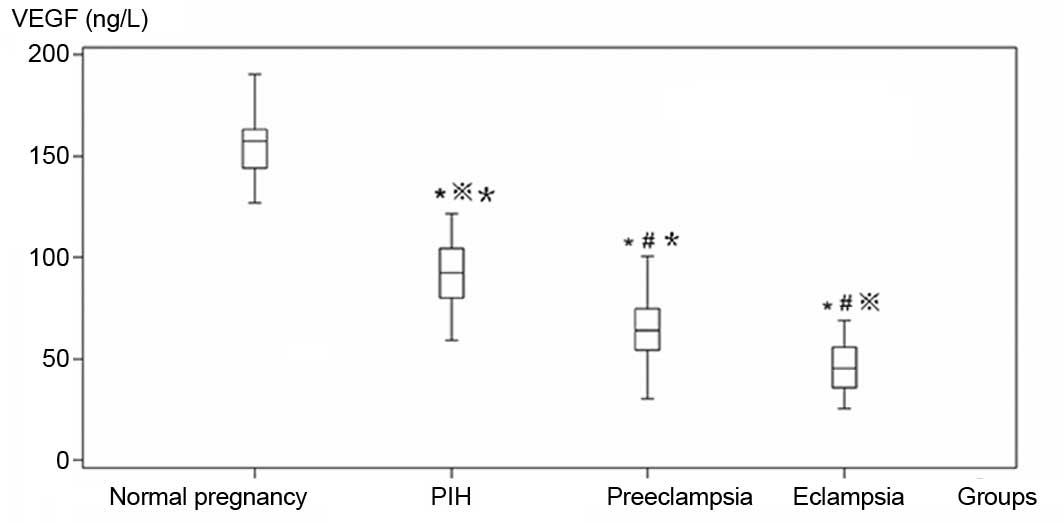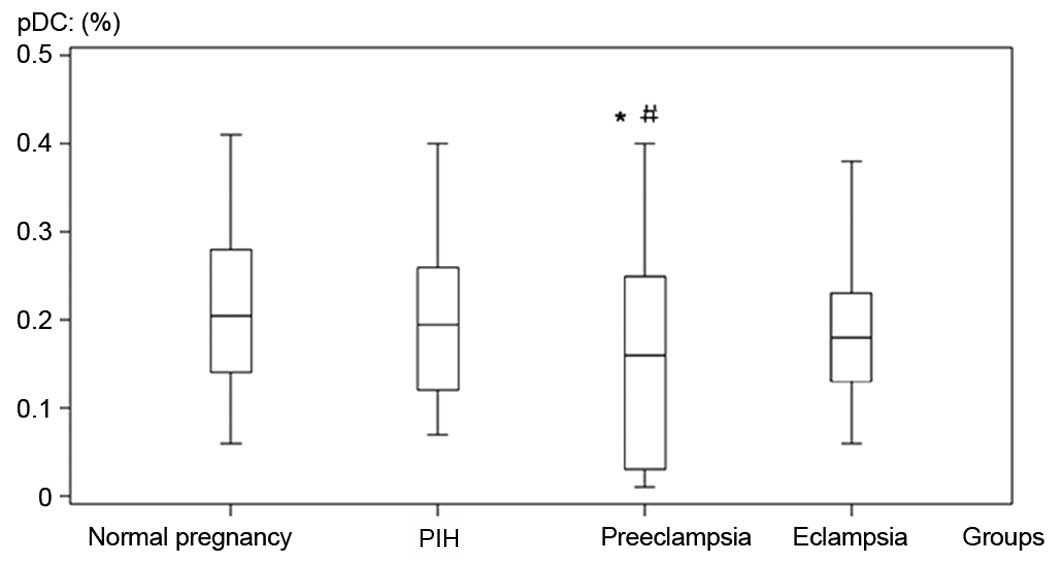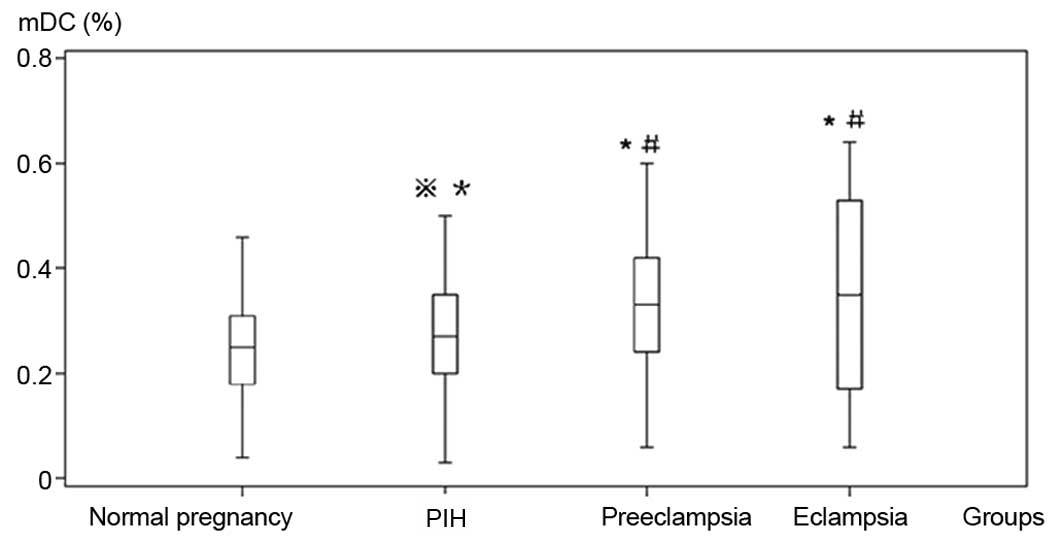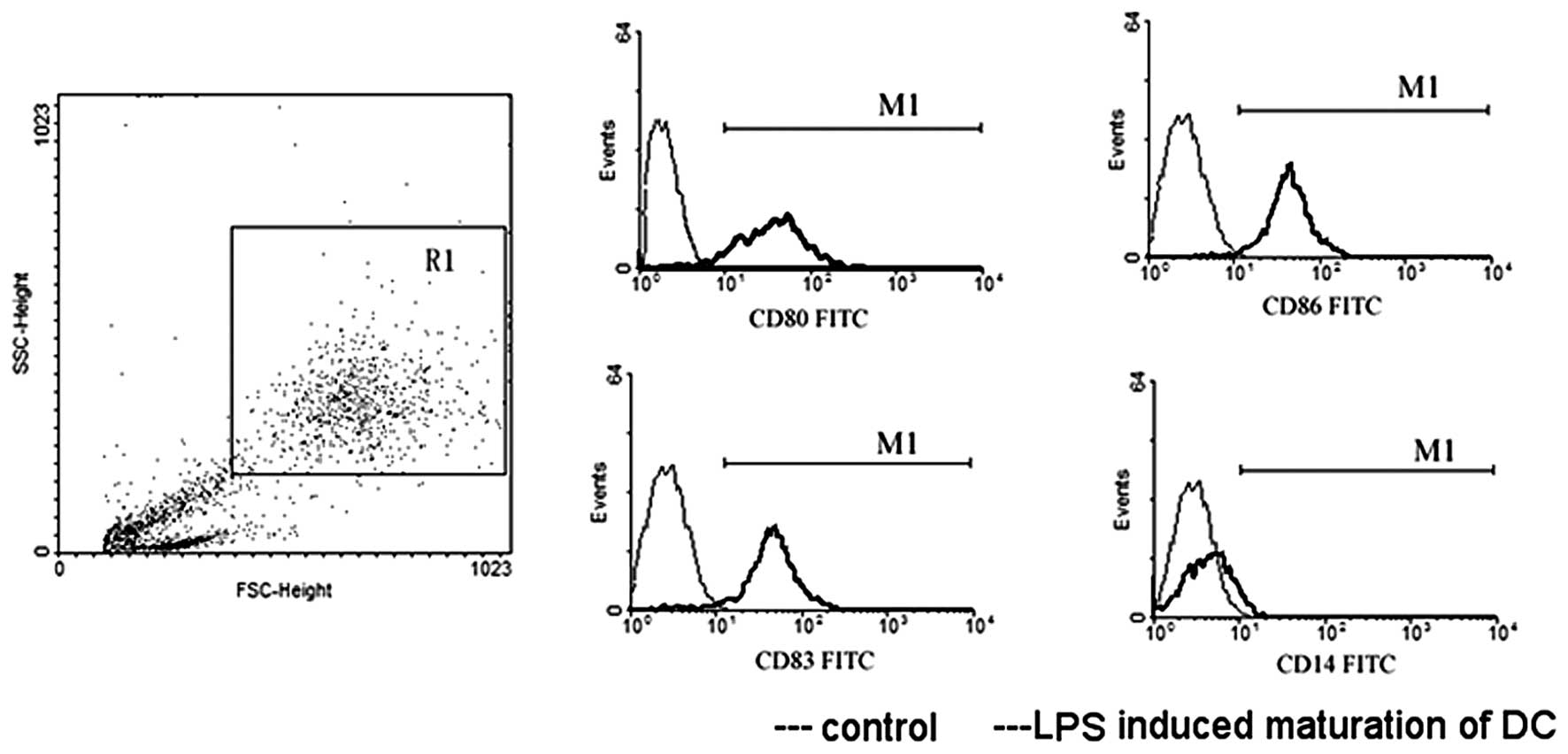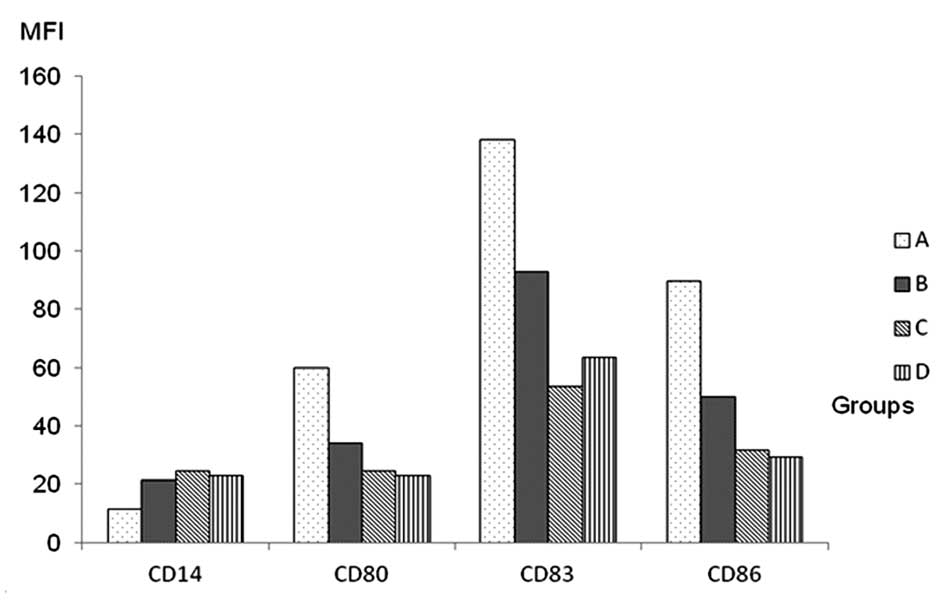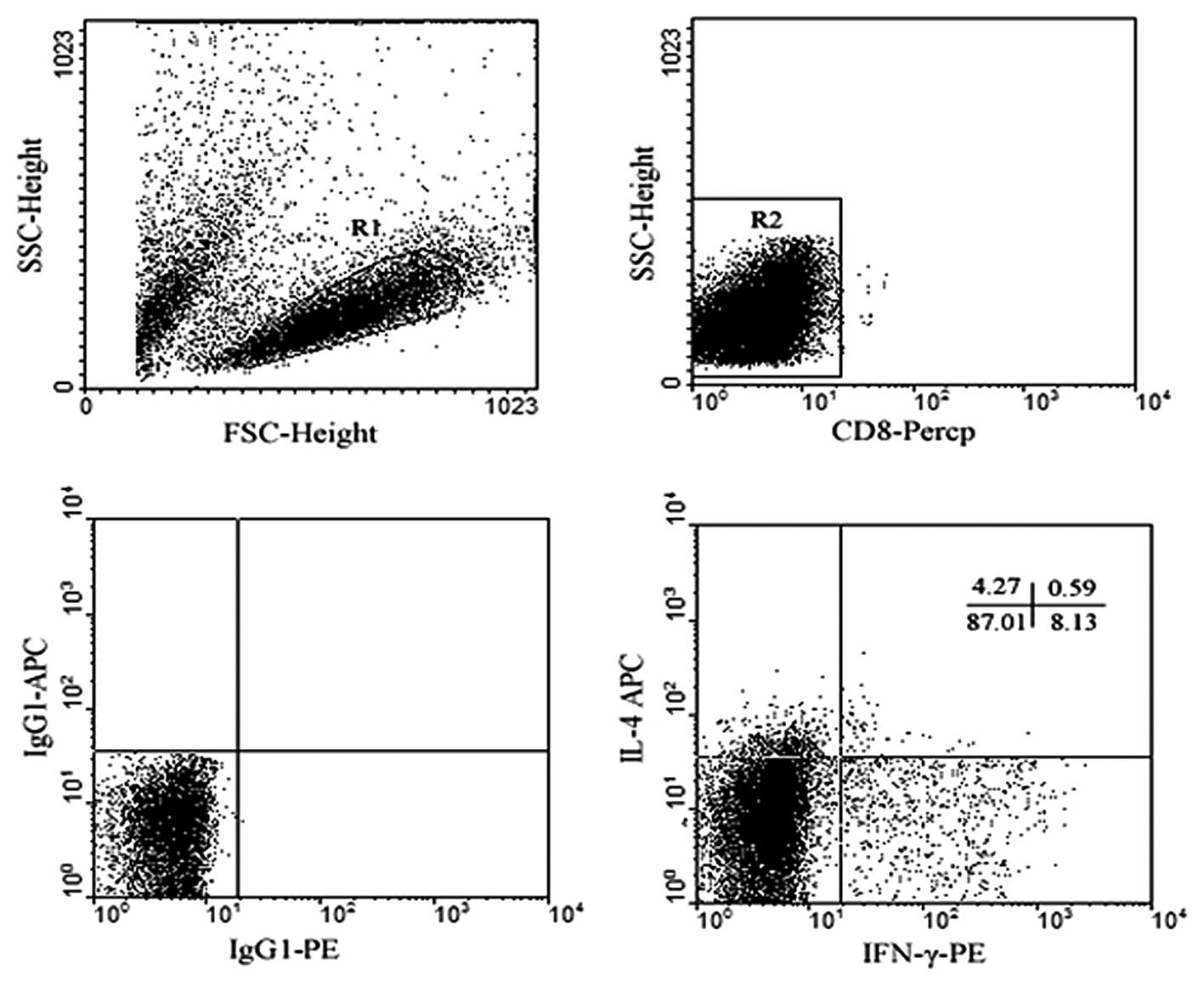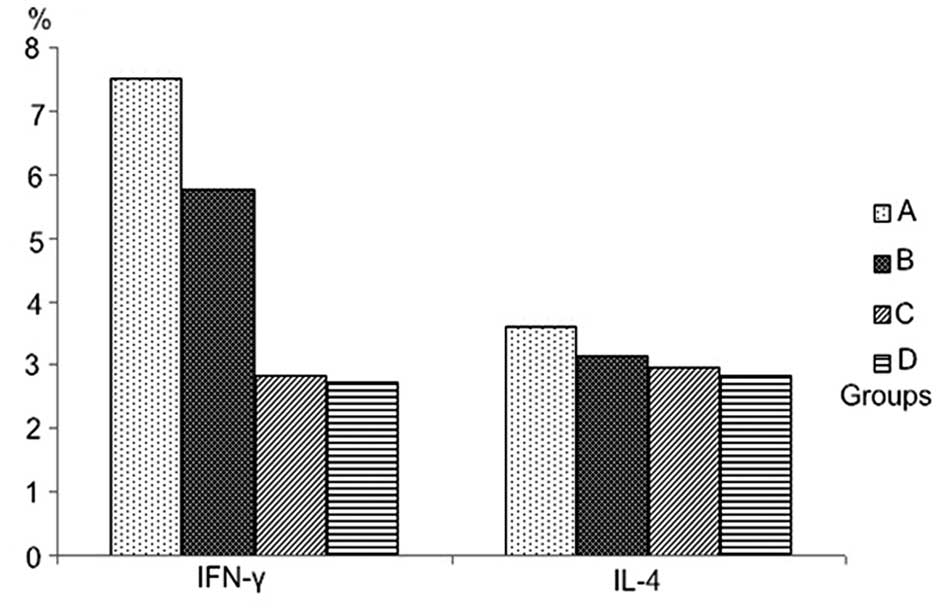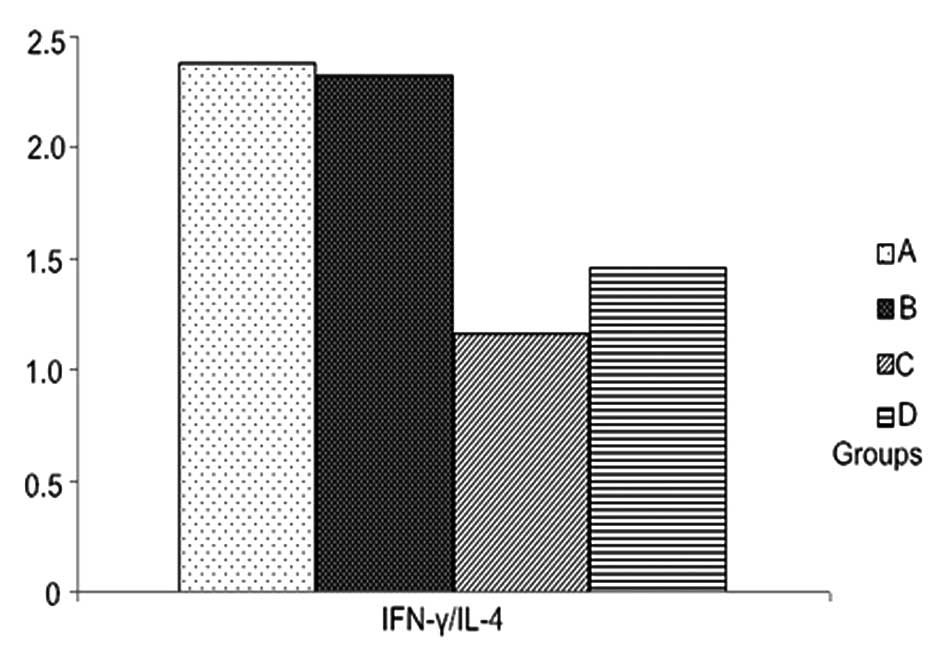Vascular endothelial growth factor affects dendritic cell activity in hypertensive disorders of pregnancy
- Authors:
- Published online on: May 14, 2015 https://doi.org/10.3892/mmr.2015.3783
- Pages: 3781-3786
Abstract
Introduction
Hypertensive disorders of pregnancy exert profound effects on maternal and infant health. Together, gestational hypertension, preeclampsia, eclampsia, chronic hypertension complicated by preeclampsia and chronic hypertension have an incidence of 9.4% in China and a worldwide incidence of 7–12% (1,2). Pregnancy-induce hypertension (PIH) disorders are a leading cause of morbidity and mortality in pregnant and parturient women, and in perineonates, and an understanding of their etiology is a significant concern within obstetrics. A number of studies have suggested roles for the placenta and the immune system in the development of these disorders (3–6).
One candidate protein that functions in the placenta as well as in the regulation of the immune system, is vascular endothelial growth factor (VEGF). VEGF is the most active vascular growth factor in the vascularization of the placenta (7), and has been shown to be involved in the physiological and pathological conditions of hypertension in pregnancy (8). VEGF also contributes to the development of dendritic cells (DCs), which are initiators of the immune response that play an important role in regulating the innate immune system (9). DCs are a heterologous population of cells, which are differentiated from CD34+ hematopoietic progenitor cells (10). Immature DCs (iDCs) have the ability to migrate and, during this process, to achieve activation and functional maturation. It has been reported that the VEGF receptor, fms-related tyrosine kinase 1 (FLT-1), is present on the surface of CD34+ cells (11,12), and that VEGF binds to FLT-1, kinase insert domain receptor/fetal liver kinase 1 (KDR/FLK-1), and FLT-4 receptors (13). Upon binding to FLT-1, VEGF inhibits the activity of the transcription factor, nuclear factor κB (NF-κB), blocking the differentiation of hematopoietic stem cells into DCs. Thus, VEGF may contribute to the development of PIH by blocking the differentiation of stem cells into DCs.
The present study sought to investigate the correlation between VEGF expression and DCs in the pathogenesis of hypertensive disorders in pregnancy, by comparing levels of VEGF and DCs in the peripheral blood of patients with hypertensive disorders, as well as evaluating the effect of VEGF on DC phenotypes, their ability to secrete cytokines and the stimulation of primary T-cell activation.
Materials and methods
Study participants
The current study recruited 112 patients undergoing treatment in the Division of Obstetrics between December 2012 and December 2013 (mean age, 27.8±2.5 years; mean gestational age, 34.1±2.3 weeks). Of these, 46 patients were diagnosed with gestational hypertension, 41 were diagnosed with preeclampsia and 25 were diagnosed with eclampsia. The study included 50 healthy pregnant women (mean age, 27.7±3.1 years; mean gestational age, 33.7±1.1 weeks) as a control group. Among the observation groups (pregnancy-induced hypertension, preeclampsia, and eclampsia), differences in maternal and gestational ages were not statistically significant, and patients had no other obstetric or medical complications, or histories of autoimmune disorders. The present study was approved by the Ethics Committee of Nantong Women and Children Health Care Hospital (Nantong, China) and all patients provided informed consent.
Antibodies and reagents
The antibodies used in the present study were mouse monoclonal antibodies (mAb) used at a dilution of 1:20 and provided by eBioscience Inc. (San Diego, CA, USA). The antbodies were as follows: Phycoerythrin (PE)-labeled anti-human CD123 antibodies (IgG1, cat. no. 12-1239), fluoresein isothiocyanate (FITC)-labeled anti-human lineage cocktail 1 (Lin 1; IgG2b, cat. no.22-7778), FITC-labeled anti-human CD80 (IgG1, cat. no. 11-0809), anti-human interferon-γ (IFN-γ; IgG1, cat. no. 53-7319), anti-human CD86 (IgG2b, cat. no. 14-0869); FITC-labeled anti-human CD83 (IgG1, cat. no. 11-0839), anti-human CD14 (IgG1, cat. no. 14-0149), PerCy5.5-labeled anti-human HLA-DR antibody (IgG2b, cat. no. 45-9956), allophycocyanin (APC)-labeled anti-human CD11C antibody (IgG1, cat. no. 17-0116), Isotype Control PerCP-Cy5.5 (mAb IgG2b, cat. no. 45-4732), Isotype Control APC (mAb IgG1, cat. no. 17-4717), Isotype Control PE (mAb IgG1, cat. no. 12-4717), Isotype Control FITC (mAb IgG2b, cat. no. 11-4732). Monensin, ionomycin, and phorbol-12-my-ristate-13-acetate (PMA; Sigma-Aldrich, St. Louis, MO, USA) were used for blocking and washing and the cells were cultured in RPMI-1640 culture medium (Gibco Life Technologies, Gaithersburg, MD, USA).
Detection of serum VEGF
Serum VEGF was detected using an enzyme-linked immunosorbent assay (ELISA), according to the manufacturer's instructions. The absorbance at 450 nm was measured using an ELISA microplate reader (iMark; Bio-Rad, Hercules, CA, USA) in order to determine the concentration of VEGF in each sample.
Detection of dendritic cells
Whole blood (50 µl) was obtained from each subject and anticoagulated with heparin. PerCy5.5-labeled anti-human HLA-DR, FITC-labeled anti-human Lin 1, APC-labeled anti-human CD11C, PE-labeled anti-human CD123, APC-labeled IgG1 isotype control, and PE-labeled IgG1 isotype control antibodies were added to each sample. After hybridizing in darkness for 30 min, 500 µl hemolytic agent was added and mixed, and samples were placed in darkness for five minutes. Samples were then washed three times using PBS, following which 300 µl of 20 g/l paraformaldehyde (PFA; Sigma-Aldrich) was added. Samples were then processed by flow cytometry in order to detect plasmacytoid dendritic cells (pDC; Lin 1-HLA-DR+CD123+) and myeloid dendritic cells (mDC; Lin1-HLA-DR+CD11C+). Data were analyzed using CellQuest Software (Beckton, Dickinson and Company, Franklin Lakes, NJ, USA).
VEGF treatment of dendritic cells
PBMCs from healthy individuals were separated by Ficoll-Hypaque (Sigma-Aldrich), then washed three times using complete RPMI-1640 medium, placed in 6-well plates at a density of 5×106 cells/l, and cultured at 37°C in 5% CO2 for 2 h. Suspended cells were removed and adherent cells were collected after they had been rinsed with RPMI-1640. Adherent cells were treated with culture medium containing cytokines (100 g/l rhIL-4 and 100 g/l rhGM-CSF). After 3 days, the cytokines were added again and half of the medium was renewed. On the sixth day, half of the medium was renewed, and immature dendritic cells (iDCs) were obtained and cultured as follows: Group A was treated with 1 mg/l LPS; and groups B, C and D were treated with 1 mg/l LPS plus 50 ng/l, 100 ng/l, and 150 ng/l VEGF, respectively. Following 8 days of culture, suspended cells were collected. The concentration was adjusted to 1×109 cells/l using RPMI-1640 medium, and DCs were collected and placed into test tubes. PerCy5.5-labeled anti-human HLA-DR antibodies; FITC-labeled anti-human CD14 and CD83 antibodies; in addition to PerCy5.5-labeled IgG1 isotype control antibodies and FITC-labeled IgG1 isotype control antibodies were added. Following hybridization in darkness for 30 min, DCs were washed three times with PBS and then added to 300 µl of 20 g/l PFA. Flow cytometry was used to measure the mean fluorescence intensity (MFI) of the different dendritic cell types. CellQuest Software was used to obtain and analyze data.
DC-induced differentiation of autologous Th0 cells
Peripheral blood mononuclear cells (PBMCs) from healthy individuals were separated and adherent cells were removed. Nylon wool columns were used to separate CD4+ and T cells. Cells were then incubated with a CD45RA antibody (mAb; IgG2b; cat. no. 14-0458-80; eBioscience; 1:20), and immunomagnetic bead separation was performed in order to obtain CD4+CD45RA+Th0 cells. Cells were resuspended in complete medium, then added to DCs at a ratio of 100:1 and placed into wells of a 24-well plate (each well had a total volume of 1 ml). The concentration was adjusted to 1×109 cells/l using RMPI-1640 medium, and on day four of cell culture. The cells (DC + Th0) were collected and analyzed using flow cytometry (BD Biosciences, Franklin Lakes, NJ, USA).
Flow cytometry
Lymphocytes were collected after 4 days of growth and cultured in 96-well plates at a concentration of 2×106 cells/ml. Ionomycin and PMA were added to bring the volume in each well to 200 µl. Cells were then incubated at 37°C in 50 ml/l CO2 for 3 h, then blocked with monensin and cultured again for 2 h. The supernatant was removed by centrifugation at 22,000 × g for 5 min, and 50 µl of the remaining liquid was placed into test tubes. CD8-PerCP (BD Pharmingen, San Diego, CA, USA) was then added. After culture in darkness at 4°C for 30 min, cell surface molecules were stained with a monoclonal antibody. The mixture was washed two times using 1 ml staining buffer, and the cells were fixed in 500 µl of 40 g/l PFA at 4°C for 30 min. The mixture was washed two times using 1 ml staining buffer, and 500 µl of 1 g/l saponin-PBS was then added to each tube. Following cell membrane permeation at 4°C for 15 min, the supernatant was removed by centrifugation at 22,000 × g for 5 min. The cells were then sealed with 20 µl of 100 ml/l bovine serum albumin. IL-4-APC (mAb; IgG1, cat. no. 17-7049; eBioscience, 1:20) and IFN-γ-PE (mAb; IgG1; cat. no. BMS107; eBioscience; 1:20) were added to test tubes to serve as an isotype control, and intracellular cytokine staining was performed, according to the manufacturer's instructions. Samples were washed with PBS, 300 µl of 40 g/l PFA was added, and detection was performed using a FACSCalibur flow cytometer (Beckton, Dickinson and Company). Cell Quest Software (Beckton, Dickinson and Company) was used to obtain and analyze data.
Statistical analysis
Data were analyzed using SAS 9.2 (SAS Institute Inc., Cary, NC, USA). Sample groups were compared using Student's t-test and linear correlation analysis. The means of multiple samples were compared using analysis of variance. P<0.05 was considered to indicate a statistically significant difference.
Results
VEGF levels and DC profiles are significantly altered in the peripheral blood of hypertensive pregnant women
VEGF levels in each hypertensive group were lower than those in the control group (Table I, Fig. 1). In addition, VEGF levels incrementally decreased in samples from each group of hypertensive patients in accordance with disease severity. Analysis of variance and a q-test showed that the differences in VEGF levels among the four groups were statistically significant (P<0.05).
Table IComparison of peripheral blood DC and VEGF levels between observation groups and the control group. |
The percentage of pDCs in the preeclampsia group was significantly lower than that in the control and pregnancy-induced hypertension groups (Table I, Fig. 2). The percentage of mDCs in each observation group was significantly higher than that of the control group, and the mDC levels in the preeclampsia and eclampsia groups were significantly higher than those in the pregnancy-induced hypertension groups (Table I, Fig. 3).
VEGF expression and mDC levels are negatively correlated in preeclamptic and eclamptic patients
In order to determine whether the observed differences in circulating VEGF and in the population of DCs in patients with PIH are associated, the correlation between VEGF and DCs was analyzed. In the control and pregnancy-induced hypertension groups, VEGF levels were not correlated with the percentage of mDCs. However, in the preeclampsia and the eclampsia groups, VEGF levels were significantly negatively correlated with the percentage of mDCs (r=−0.34 and −0.42, respectively; P<0.05; Table II). There was no significant correlation between VEGF levels and the percentage of pDCs among any of the groups.
VEGF affects the maturation and differentiation of DCs
DCs cultured with LPS matured, and consequently exhibited increased expression of CD83, as well as the co-stimulatory molecules CD80 and CD86, while the expression of CD14 decreased. Fig. 4 shows a sample expression profile of CD14, CD80, CD83 and CD86 from cells in group A. The MFI levels of DC surface molecules in the three groups treated with VEGF were lower than those in group treated with LPS, and their differences were statistically significant (P<0.05). The differences in the expression of CD14, CD80, CD83 and CD86 between groups C and D were not statistically significant. However, there was a significant difference between these groups and group B (Table III, Fig. 5).
Cytokines are produced during Th0 differentiation induced by DCs
A typical cytokine profile is shown in Fig. 6. The expression of IFN-γ in the group treated with LPS alone was the highest, but there were not statistically significant differences in the expression levels of IL-4 among the four groups and the ratios of IFN-γ/IL-4 between the group treated with 50 ng/l VEGF and with LPS. IFN-γ/IL-4 ratios in the groups treated with 100 ng/1 and 150 ng/l VEGF were significantly lower than those treated with LPS alone (Table IV, Figs. 7 and 8).
Discussion
The present study showed that VEGF levels in each hypertensive group were lower than those in the control group, and that the more severe hypertensive cases were associated with lower VEGF levels. The expression of mDCs in peripheral blood samples was higher in the preeclampsia and eclampsia groups than that in the control pregnancy-induced hypertension groups, and was negatively correlated with VEGF levels. Only in the preeclampsia group were pDCs found to be lower than those in the control and pregnancy-induced hypertension groups, and both differences were statistically significant. However, the correlation of pDCs with VEGF levels was not significant. These results suggest that, at a high concentration, VEGF may inhibit differentiation into mDCs, while it appears to have no inhibitory effects on the level of pDCs.
Notably, Schonkeren et al (14) found that soluble FLT-1 (sFLT-1) expression on the surface of CD14+ macrophages in patients with preeclampsia was increased as a result of the action of VEGF on sFLT-1, thereby inhibiting the differentiation of CD14+ precursor cells into DCs. Further, Stober et al (15) demonstrated that mDCs stimulate and regulate T cells to secrete large quantities of the cytokines IL-12, IL-18, TNF-α and IFN-γ, activating T cell proliferation and promoting the differentiation of Th0 cells into Th1 cells. Therefore, VEGF may reduce the function and number of mDCs and inhibit the appearance of Th1-type cytokines, thus encouraging a normal pregnancy.
The present study also demonstrated that VEGF may inhibit DC maturation, and that VEGF levels most similar to those observed in the normal pregnancy group, exerted the strongest inhibitory effect. When VEGF was given to autologous primary T cells, stimulated by DCs, it inhibited the activation of primary T cells stimulated by mDCs. Furthermore, lower VEGF levels resulted in stronger MFI on the surface of DCs, increased DC maturity, and an enhanced ability to produce Th1-type cytokines in stimulated primary T cells. In addition, the ratio of Th1/Th2 also rose. This is in accordance with a study by Block et al (16) which showed that VEGF reduced the expression of IL-12β, which causes CD4 T cells to differentiate into Th1 cells in response to DCs. Chen et al (17) also reported that highly expressed VEGF may reduce the function and number of mDCs, and contribute to immunosuppression.
Numerous studies have illustrated the interaction between VEGF and DCs (18–21), in which VEGF expression leads to abnormal DC phenotypes and functions. The present study suggests that VEGF levels in normal pregnancies may inhibit the maturation of DCs and inhibit the differentiation of Th0 cells into Th1 cells, indicating that the interaction between VEGF and DCs is important in maintaining the maternal-fetal immune balance. These results provide a basis for a greater understanding of the molecular pathogenesis of hypertensive disorders of pregnancy.
Acknowledgments
This study was supported by Jiangsu Provincial Health Department (grant no. F 201213).
References
|
Gaio DS, Schmidt MI, Duncan BB, et al: Hypertensive disorders in pregnancy: Frequency and associated factors in a cohort of Brazilian women. Hypertens Pregnancy. 20:269–281. 2001. View Article : Google Scholar | |
|
Lykke JA, Langhoff-Roos J, Sibai BM, et al: Hypertensive pregnancy disorders and subsequent cardiovascular morbidity and type 2 diabetes mellitus in the mother. Hypertension. 53:944–951. 2009. View Article : Google Scholar : PubMed/NCBI | |
|
Nahar L, Nahar K, Hossain MI, Jahan S and Rahman MM: Placental changes in pregnancy induced hypertension. Mymensingh Med J. 22:684–693. 2013.PubMed/NCBI | |
|
Nahar L, Nahar K, Hossain MI, Yasmin H and Annur BM: Placental changes in pregnancy induced hypertension and its impacts on fetal outcome. Mymensingh Med J. 24:9–17. 2015.PubMed/NCBI | |
|
LaMarca B, Cornelius D and Wallace K: Elucidating immune mechanisms causing hypertension during pregnancy. Physiology (Bethesda). 28:225–233. 2013. | |
|
Cao X, Wang LL and Luo X: Expression of regulatory T and helper T cells in peripheral blood of patients with pregnancy-induced hypertension. Clin Exp Obstet Gynecol. 40:502–504. 2013.PubMed/NCBI | |
|
Kalkunte SS, Mselle TF, Norris WE, et al: Vascular endothelial growth factor C facilitates immune tolerance and endovascular activity of human uterine NK cells at the maternal-fetal interface. J Immunol. 182:4085–4092. 2009. View Article : Google Scholar : PubMed/NCBI | |
|
Tripathi R, Ralhan R, Saxena S, et al: Soluble VEGFR-1 in pathophysiology of pregnancies complicated by hypertensive disorders: The Indian scenario. J Human Hypertens. 27:107–114. 2012. View Article : Google Scholar | |
|
Geissmann F, Auffray C, Palframan R, et al: Blood monocytes: Distinct subsets, how they relate to dendritic cells and their possible roles in the regulation of T-cell responses. Immunol Cell Biol. 86:398–408. 2008. View Article : Google Scholar : PubMed/NCBI | |
|
van de Laar L, Buitenhuis M, Wensveen FM, et al: Human CD34-derived myeloid dendritic cell development requires intact phosphatidylinositol 3-kinase-protein kinase B-mammalian target of rapamycin signaling. J Immunol. 184:6600–6611. 2010. View Article : Google Scholar : PubMed/NCBI | |
|
Laxmanan S, Robertson SW, Wang E, et al: Vascular endothelial growth factor impairs the functional ability of dendritic cells through Id pathways. Biochem Biophys Res Comm. 334:193–198. 2005. View Article : Google Scholar : PubMed/NCBI | |
|
Oyama T, Ran S, Ishida T, et al: Vascular endothelial growth factor affects dendritic cell maturation through the inhibition of nuclear factor-kappa B activation in hemopoietic progenitor cells. J Immunol. 160:1224–1232. 1998.PubMed/NCBI | |
|
Seetharam L, Gotoh N, Maru Y, et al: A unique signal transduction from FLT tyrosine kinase, a receptor for vascular endothelial growth factor VEGF. Oncogene. 10:135–147. 1995.PubMed/NCBI | |
|
Schonkeren D, van der Hoorn ML, Khedoe P, et al: Differential distribution and phenotype of decidual macrophages in preeclamptic versus control pregnancies. Am J Pathol. 178:709–717. 2011. View Article : Google Scholar : PubMed/NCBI | |
|
Stober D, Schirmbeck R and Reimann J: IL-12/IL-18-dependent IFN-γ release by murine dendritic cells. J Immunol. 167:957–965. 2001. View Article : Google Scholar : PubMed/NCBI | |
|
Block MS, Nevala WK, Leontovich AA, et al: Differential response of human and mouse dendritic cells to VEGF determines interspecies discrepancies in tumor-mediated TH1/TH2 polarity shift. Clin Cancer Res. 17:1776–1783. 2011. View Article : Google Scholar : PubMed/NCBI | |
|
Chen Z, Varney ML, Backora MW, et al: Down-regulation of vascular endothelial cell growth factor-C expression using small interfering RNA vectors in mammary tumors inhibits tumor lymphangiogenesis and spontaneous metastasis and enhances survival. Cancer Res. 65:9004–9011. 2005. View Article : Google Scholar : PubMed/NCBI | |
|
Vicari AP, Treilleux I and Lebecque S: Regulation of the trafficking of tumour-infiltrating dendritic cells by chemokines. Semin Cancer Biol. 14:161–169. 2004. View Article : Google Scholar : PubMed/NCBI | |
|
Berger S, Dyugovskaya L, Polyakov A, et al: Short-term fibronectin treatment induces endothelial-like and angiogenic properties in monocyte-derived immature dendritic cells: involvement of intracellular VEGF and MAPK regulation. Eur J Cell Biol. 91:640–653. 2012. View Article : Google Scholar : PubMed/NCBI | |
|
Mahnke K, Schmitt E, Bonifaz L, et al: Immature, but not inactive: The tolerogenic function of immature dendritic cells. Immunol Cell Biol. 80:477–483. 2002. View Article : Google Scholar : PubMed/NCBI | |
|
Sugiyama M, Kakeji Y, Tsujitani S, et al: Antagonism of VEGF by genetically engineered dendritic cells is essential to induce antitumor immunity against malignant ascites. Mol Cancer Ther. 10:540–549. 2011. View Article : Google Scholar : PubMed/NCBI |



